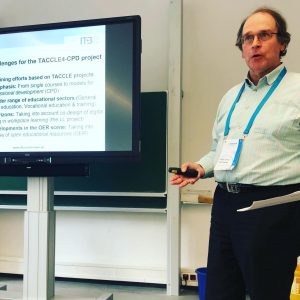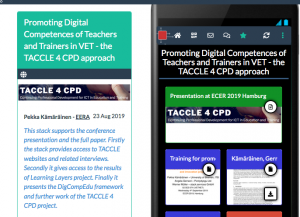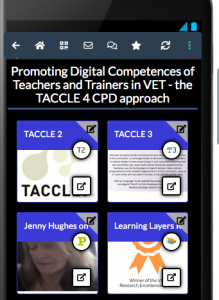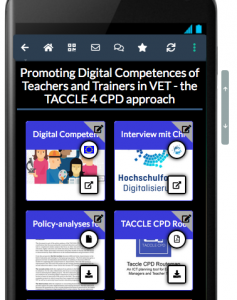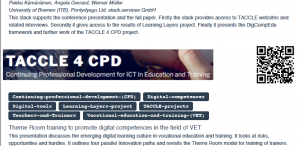The Paderborn-based project: Adopting apprentice training to digital transformation – the perspective of in-company training
The presentation of Bernd Gössling and Tina Emmler was in many respects one of the highlights of this conference. I had already become aware of the work of the research group of the University of Paderborn via the report “Berufsbildung 4.0” (Sloane et alia 2018). For me it had served as a rich resource in terms of conceptual work, empirical studies and conclusions for future-oriented innovation agendas. In particular the distinction between ‘digital transformation’ (technological and organisational changes towards networked production, marketing and service processes) and ‘digitization’ (introduction of digital tools into working, training and learning processes) was very helpful. Now the presentation of Gössling and Emmler provided a closer look into the empirical studies and findings. I do not want to summarise their results here – we need to discuss them more closely. Also, the reflections on the new roles of trainers that Emmler outlined (in terms of “vita activa”) were very inspiring and reminded me of our experiences with trainers working with the Learning Toolbox at the end of the Learning Layers project.
The Bremen-based project CARO: Digital cross-action spaces in interactive nursing education
Another highlight for me was the project CARO presented by Claudia Schepers from the University of Bremen. This interdisciplinary research & development project had shaped digital learning spaces to support interactive learning arenas in nursing education. Here we need to understand the delicate nature of learning in the context of real work and the necessity to support such work with simulations, videos and reflective learning. For me this case was particularly important since I had been looking at different innovation paths for introducing digital tools into vocational learning. To me, this project appeared as a paradigmatic case for introducing digital tools and digital spaces with a ‘whole curriculum’ approach. Furthermore, all my examples that I had used were referring to technical occupations. From this perspective a case from healthcare sector was most welcome.
The Aachen-based innowas project: Acceptance of a tutorial-creating authoring system for workplace learning in manual assembly
A third highlight for me was the Aachen-based innowas project presented by Marvin Goppold and Fabian Handl. Their project focused on the role of low-skilled or semi-skilled workers in manual assembly and their occupational perspectives in the context of digital transformation. The key point in the project was to capture the (informal) competences and (invisible) workplace-based learning and to make it visible via an authoring tool that generates individual tutorials. In this way the workers were better prepared to encounter changes that bring robotics into picture and to point out the limits of robotics. Here I do not want to go into details, I need to learn more.
As I am concerned, the innowas project served to me as a paradigmatic case for an innovation path that uses digital tools to make visible the hitherto invisible and non-formal learning of semi-skilled workers. So far I had referred to a case of process industry, but the case of assembly work and the use of authoring tools is of particular interest.
—
I guess that this is enough of these sessions. As I have said above, I need to learn more of these projects to make appropriate use of their approaches, results and conclusions. There is more work to be done on this front.
